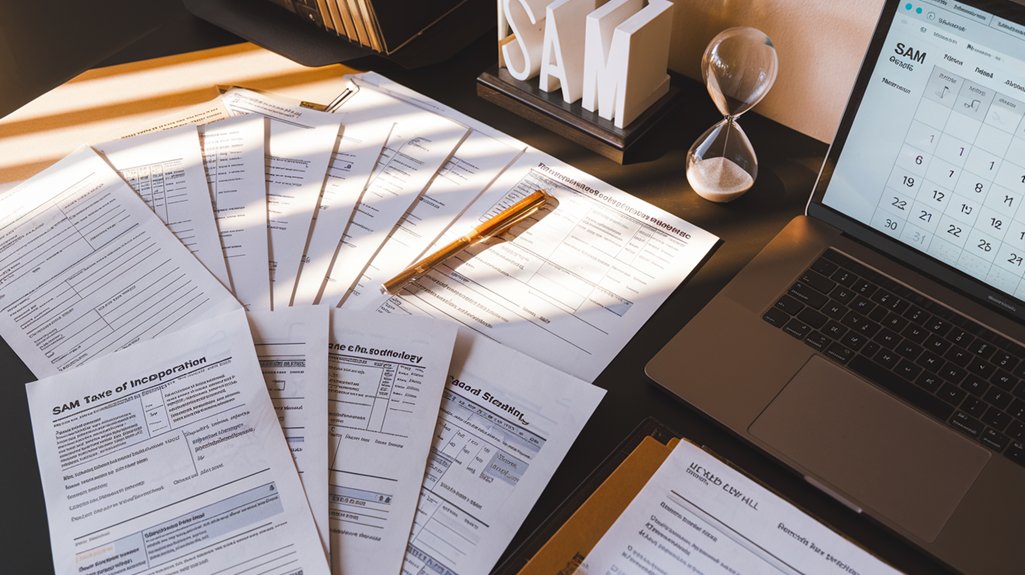To register in SAM for federal grants, organizations need: legal name as shown on IRS records, verified physical address, TIN/EIN, Unique Entity ID from SAM.gov, and a notarized letter from an authorized official. Additional requirements include active SAM status, banking details for fund transfers, and compliance documentation with federal regulations. Annual renewals are mandatory, with updates required for any organizational changes. The following documentation checklist guarantees seamless grant application eligibility and prevents funding delays.
Essential Documents for SAM Registration

Preparation of the proper documentation forms the foundation of a successful System for Award Management (SAM) registration process. Organizations must compile a complete document checklist before initiating their application to avoid delays or rejections.
The essential documentation includes the entity’s legal name as it appears in IRS records, physical address verification, and the Taxpayer Identification Number (TIN) or Employer Identification Number (EIN).
Accurate documentation of your entity’s IRS-registered name, verified address, and TIN/EIN forms the cornerstone of SAM registration success.
Additionally, entities need their Unique Entity ID from SAM.gov, which can be obtained separately from the full registration process if necessary.
A notarized letter from an authorized official is mandatory to verify registration authority, containing the legal name and credentials of the registering official.
This verification step protects against unauthorized or fraudulent registration attempts within the federal award system.
Maintaining proper documentation ensures nonprofit funding eligibility for both current and future federal grant opportunities.
Entity Information Requirements for Grant Eligibility

For entities seeking federal grant eligibility, specific information requirements must be met within the System for Award Management (SAM) registration process.
The registration requires a Unique Entity Identifier (UEI), which has replaced the DUNS number for federal entity identification purposes. Organizations must provide accurate business information, including legal name, physical address, and Taxpayer Identification Number (TIN) as it appears on the most recent tax return. This centralized system helps enhance grant transparency and simplifies the overall application process for federal funding opportunities.
Active SAM registration is mandatory for all federal grant applicants, as this data integrates with Grants.gov and JustGrants systems. The registration process takes approximately 10 business days to complete once all documentation is submitted.
The registration process also requires banking details for fund transfers, executive compensation information, and representations regarding compliance with federal regulations. Entities must guarantee their registration remains current through annual renewals and immediate updates to any changes in organizational information.
Validation Documentation for Successful SAM Renewal

Maintaining a valid System for Award Management (SAM) registration requires specific documentation that organizations must prepare before initiating the renewal process.
The renewal timeline begins 30 days before the expiration date, which occurs annually, 365 days from initial registration. Federal grants require an active SAM registration to maintain funding eligibility.
Mark your calendars 30 days before your SAM registration expires annually, one year from your initial signup date.
Essential documentation includes business entity verification materials such as articles of incorporation, partnership agreements, and certificates of good standing. Organizations must also provide tax identification information, including their EIN or SSN for sole proprietorships. Starting the renewal process early allows sufficient time to address any unforeseen issues that may arise during submission.
Compliance verification is a critical component of SAM renewal. Organizations must ascertain all submitted information is accurate and current.
Any discrepancies or outstanding tax issues can delay the renewal process. The Unique Entity ID serves as the primary identifier throughout this procedure, which must be completed before the current registration expires.
Frequently Asked Questions
Can Foreign Entities Register in SAM for U.S. Federal Grants?
Yes, foreign entities can register in the System for Award Management (SAM) for U.S. federal grants.
The foreign eligibility criteria include providing a precise legal business name and address that matches across all systems, and obtaining a Unique Entity ID (UEI).
The international registration process requires creating a login.gov account with multi-factor authentication, submitting entity information, and allowing up to 45 business days for completion, with an average of 14 days.
How Do I Recover Access if My SAM Administrator Leaves?
When the SAM administrator leaves an organization, access recovery requires a specific administrator change process.
The entity must submit a notarized Entity Administrator Appointment Letter to the Federal Service Desk (FSD). This letter should be on company letterhead, signed by an authorized official, and include the entity’s DUNS number and CAGE code.
After verification, FSD will assign administrator privileges to the designated replacement, restoring full access to the SAM.gov profile.
Are Tribal Governments Subject to Different SAM Registration Requirements?
Tribal governments follow the same core SAM registration process as other entities while maintaining their tribal sovereignty. They must obtain a UEI and complete all standard registration sections in SAM.gov.
However, tribal organizations enjoy certain exemptions from SAM registration when acting as federal contractors, though these exemptions typically don’t apply to grant funding.
For grants, tribal governments must maintain an active SAM registration to receive federal financial assistance like all other recipients.
Can Multiple Duns/Uei Numbers Be Associated With One Registration?
Multiple DUNS numbers could historically be associated with different business locations.
However, under the current UEI registration process, each entity can only have one UEI associated with its SAM registration. Since April 4, 2022, the UEI has replaced DUNS as the primary identifier, eliminating the need for multiple numbers.
Organizations with complex structures can still maintain their hierarchical relationships through SAM.gov’s entity management features.
What Happens if My CAGE Code Information Is Rejected?
When CAGE code information is rejected, entities face several challenges in the federal contracting process. The rejection typically requires correction of inaccurate data and resubmission of the registration.
Organizations must respond promptly to DLA validation emails to prevent registration closure.
CAGE code challenges can delay contracts, jeopardize payments, and necessitate starting the registration process again.
For registration appeals, entities should correct errors, contact support services if needed, and guarantee consistency across all federal databases.